Wat Kork Soong, Songkhla
B.E. 2519 / 1st Batch
*Sold*
 Anyone, of any religion or none, can appreciate these fundamental, practical guidelines about actions & speech suggested by the Buddha.
Anyone, of any religion or none, can appreciate these fundamental, practical guidelines about actions & speech suggested by the Buddha. The discourse on Loving Kindness
The discourse on Loving Kindness Tod Kratin - lasts for 30 days,from Ork Phansa through to the full month of the twelfth month of the Buddhist lunar year. During this time most Buddhists take part in ceremonies,either directly or indirectly. Robes & other necessities of temple life are offered ceremoniously to the monks on an appointed day. Each temple may hold a Tod Kartin ceremony once each year. Originally,in the time of the Lord Buddha,this ceremony was meant to teach monks humility & show them how to cut,sew, & dye the robes for themselves. The finished robes were then offered to the members of the company deemed most suitable. Today,however,the ritual has evolved dramatically into a grand celebration where hundreds & thousands of people join in the merit making. It is also an important occasion for the temple to raise funds. The sequence of events for each of the above three religious days goes something like this: Early in the morning,people begin to arrive at the temple wearing their best clothes. They carry food prepared at home,usually in highly decorative gold or silver bowls,& offer it to the monks. After this breakfast,the people are blessed by the monks & many return to their homes. The more devoted may choose to remain at the temple &,later in the morning,take a vow with the monks to keep either five or eight precepts throughout the entire day. After taking this vow,they split their time between praying,listening to the monks' preachings & doing meditation. In the evening,the monks lead a candlelit procession,making three complete circuits of the main temple building. This event signifies the end of the celebrations.
Tod Kratin - lasts for 30 days,from Ork Phansa through to the full month of the twelfth month of the Buddhist lunar year. During this time most Buddhists take part in ceremonies,either directly or indirectly. Robes & other necessities of temple life are offered ceremoniously to the monks on an appointed day. Each temple may hold a Tod Kartin ceremony once each year. Originally,in the time of the Lord Buddha,this ceremony was meant to teach monks humility & show them how to cut,sew, & dye the robes for themselves. The finished robes were then offered to the members of the company deemed most suitable. Today,however,the ritual has evolved dramatically into a grand celebration where hundreds & thousands of people join in the merit making. It is also an important occasion for the temple to raise funds. The sequence of events for each of the above three religious days goes something like this: Early in the morning,people begin to arrive at the temple wearing their best clothes. They carry food prepared at home,usually in highly decorative gold or silver bowls,& offer it to the monks. After this breakfast,the people are blessed by the monks & many return to their homes. The more devoted may choose to remain at the temple &,later in the morning,take a vow with the monks to keep either five or eight precepts throughout the entire day. After taking this vow,they split their time between praying,listening to the monks' preachings & doing meditation. In the evening,the monks lead a candlelit procession,making three complete circuits of the main temple building. This event signifies the end of the celebrations.

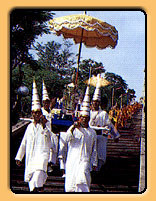
 ence of events for each of the above three religious days goes something like this: Early in the morning, people begin to arrive at the temple wearing their best clothes. They carry food prepared at home, usually in highly decorative gold or silver bowls, and offer it to the monks. After this breakfast, the people are blessed by the monks and many return to their homes. The more devoted may choose to remain at the temple and, later in the morning, take a vow with the monks to keep either five or eight precepts throughout the entire day. After taking this vow, they split their time between praying, listening to the monks’ preachings and doing meditation. In the evening, the monks lead a candle lit procession, making three complete circuits of the main temple building. This event signifies the end of the celebrations.
ence of events for each of the above three religious days goes something like this: Early in the morning, people begin to arrive at the temple wearing their best clothes. They carry food prepared at home, usually in highly decorative gold or silver bowls, and offer it to the monks. After this breakfast, the people are blessed by the monks and many return to their homes. The more devoted may choose to remain at the temple and, later in the morning, take a vow with the monks to keep either five or eight precepts throughout the entire day. After taking this vow, they split their time between praying, listening to the monks’ preachings and doing meditation. In the evening, the monks lead a candle lit procession, making three complete circuits of the main temple building. This event signifies the end of the celebrations.


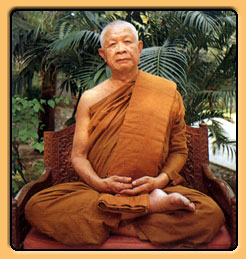
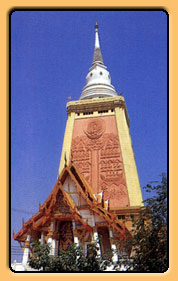 economic boom and he could only expect to receive donations of 10 or 20 baht from his devotees but, slowly, the temple complex began to take shape.
economic boom and he could only expect to receive donations of 10 or 20 baht from his devotees but, slowly, the temple complex began to take shape.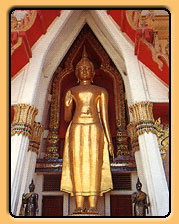
 The Jade Buddha
The Jade Buddha 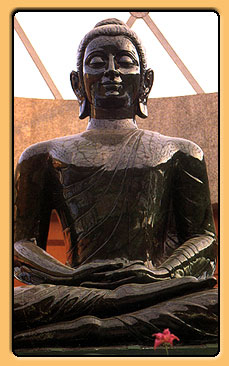

 Luang Phor Phrom Wat Chong Kair passed away on 30th January BE 2518 at the age 96 years old.
Luang Phor Phrom Wat Chong Kair passed away on 30th January BE 2518 at the age 96 years old.